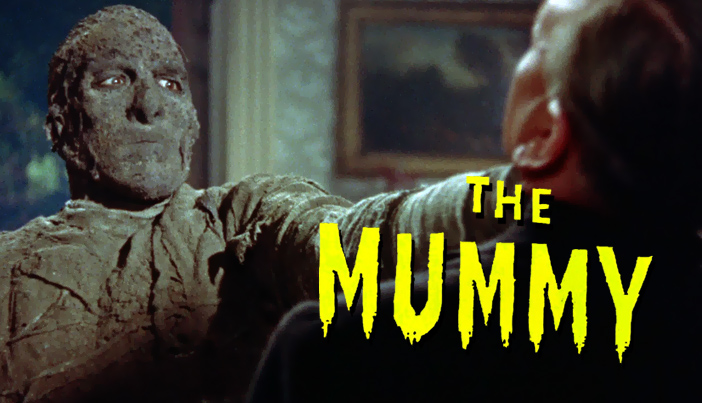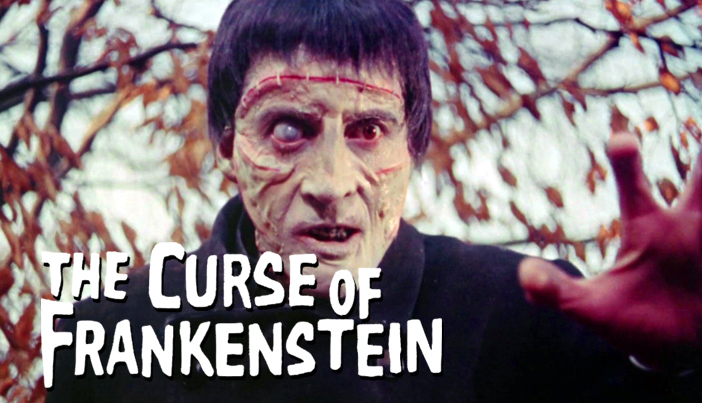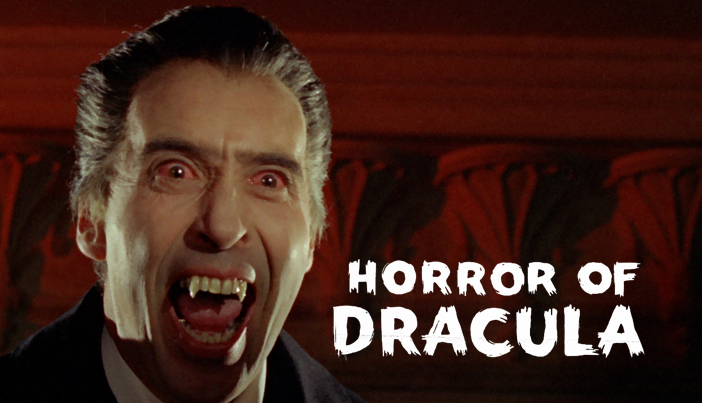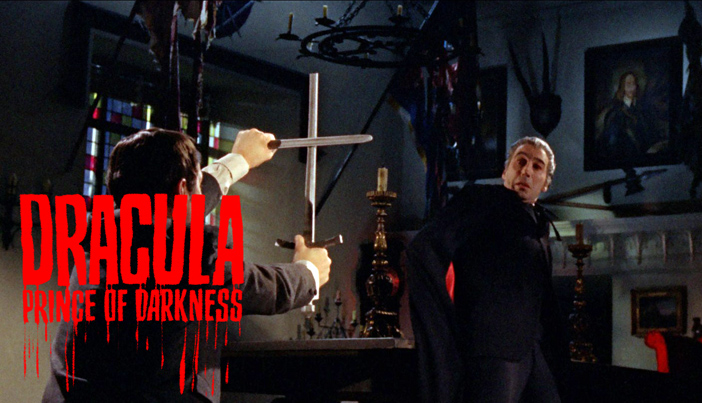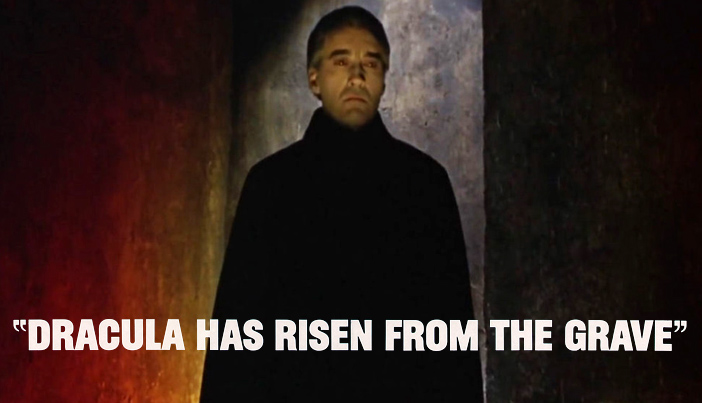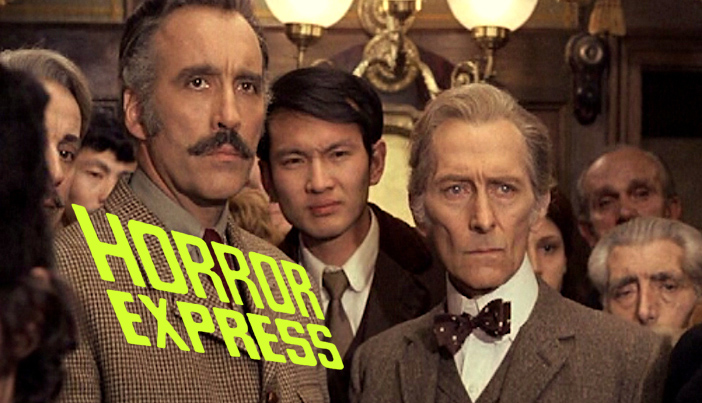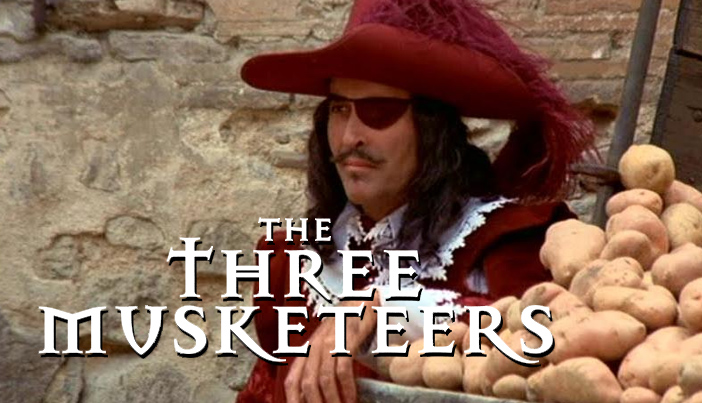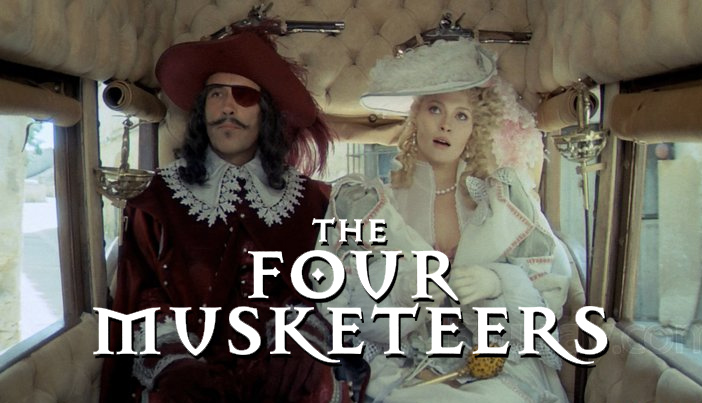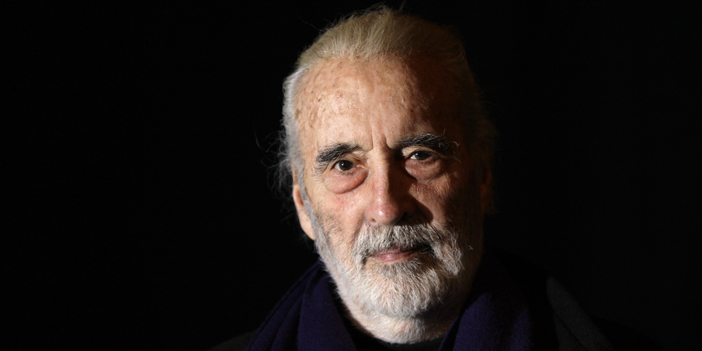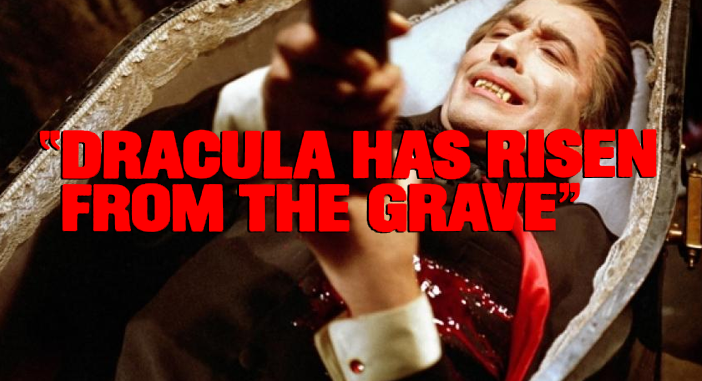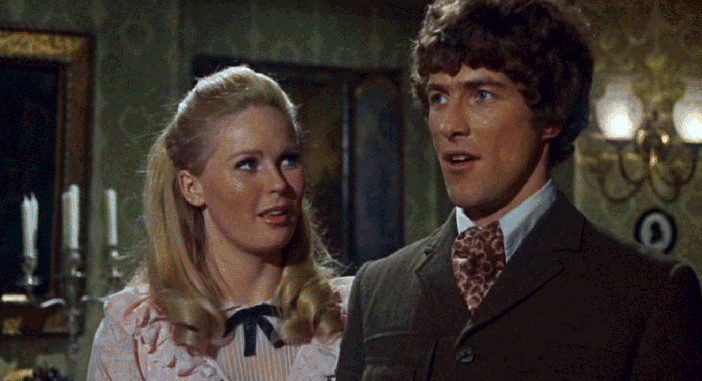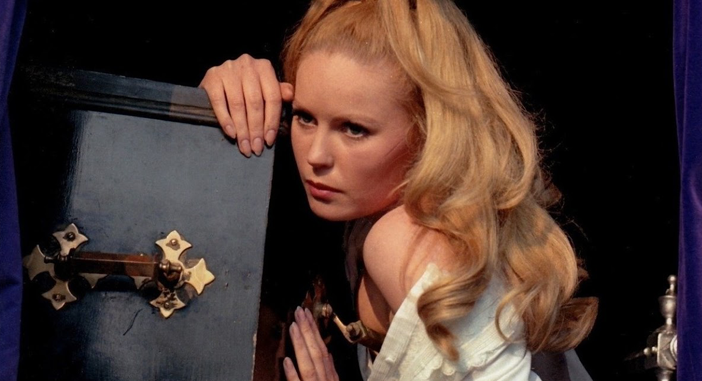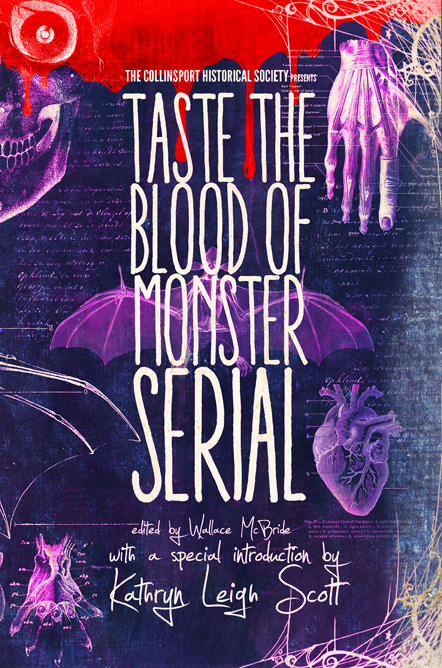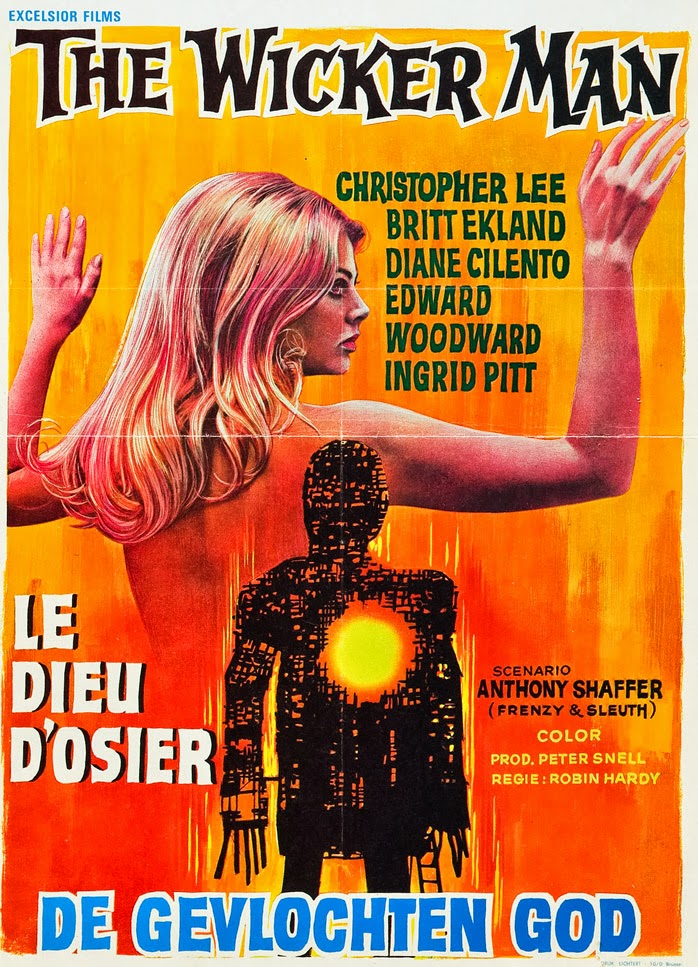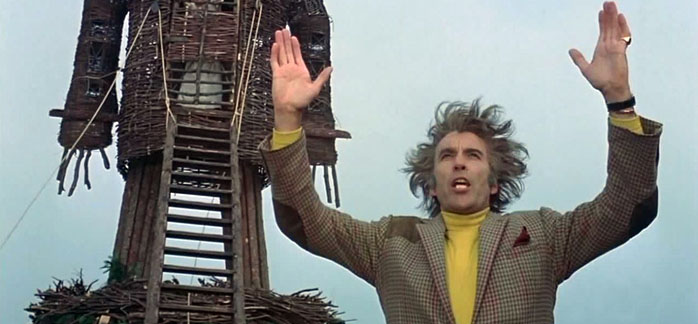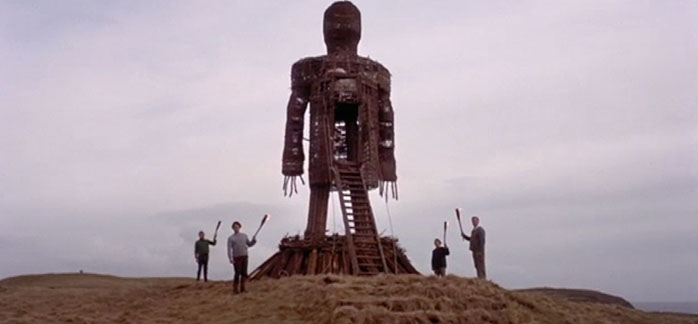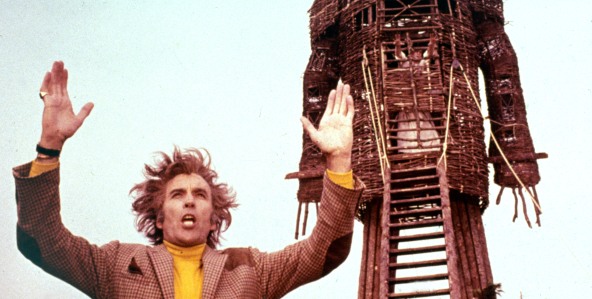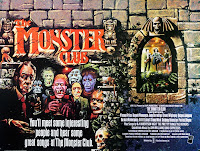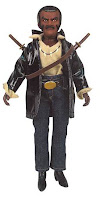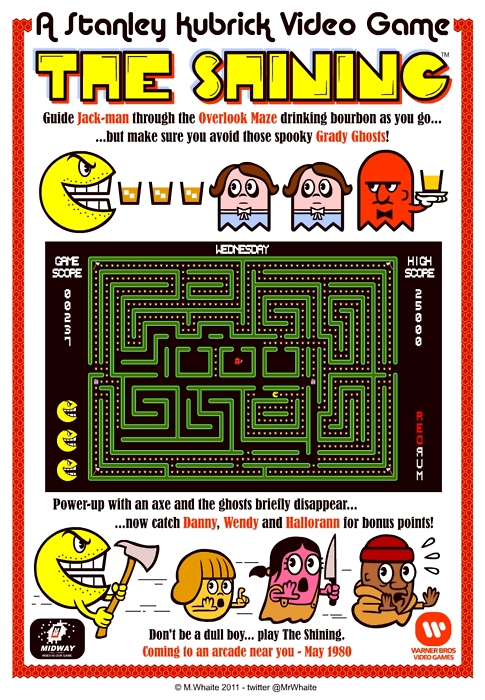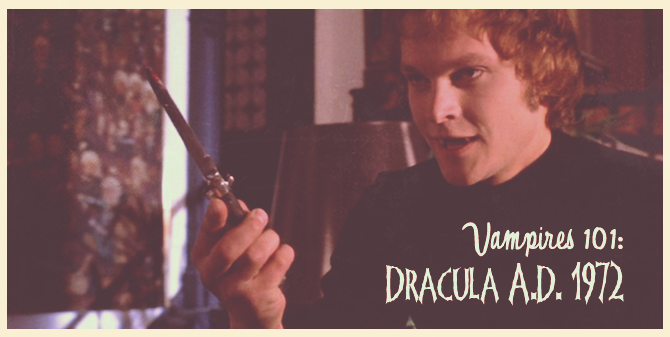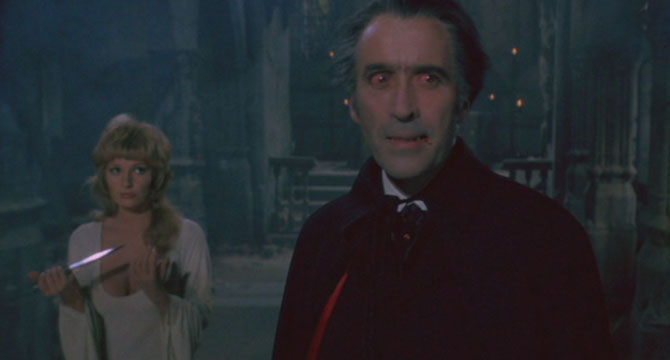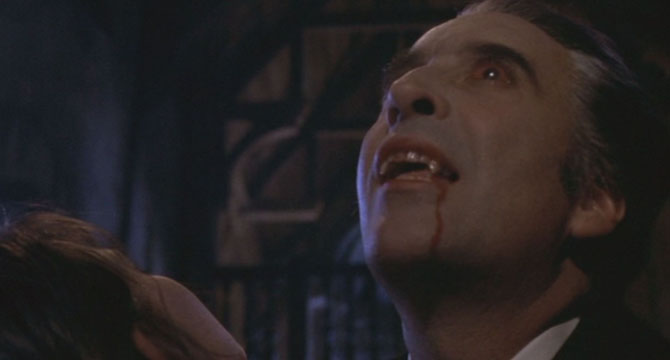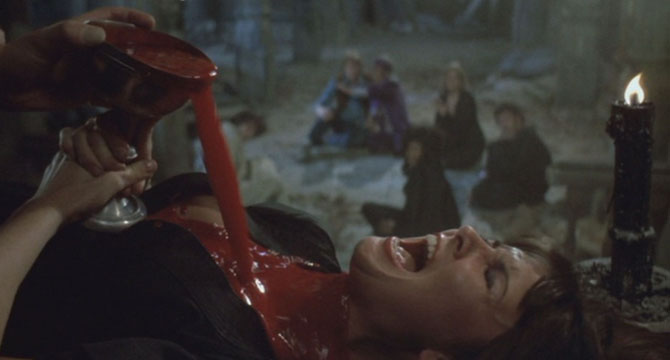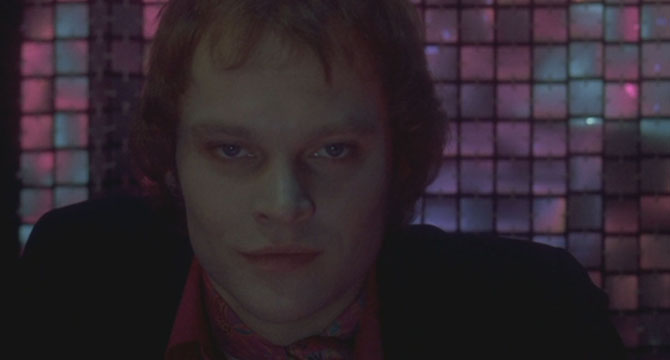By FRANK JAY GRUBER
Of all the classic monster archetypes, the one most dependent on the forms of belief is the vampire. Belief or disbelief in the creature’s existence is often pivotal to the plot, there is a realignment of each victim’s faith and allegiance after each new seductive attack, and the fiend suffers from its vulnerability to the religious iconography of the crucifix when backed up by strong conviction. While, for example, the Frankenstein monster or the Black Lagoon’s creature just attack victims and are defeated in straightforward fashion, vampire movies usually deal with the interplay of credence and conviction. Nowhere is this more in evidence than in 1968’s DRACULA HAS RISEN FROM THE GRAVE, the third film in the Hammer series starring Christopher Lee.
The story begins with a flashback sequence set during the notorious count’s previous reign of terror in 1966’s Dracula - Prince of Darkness, which ended with the undead being’s plunge into the icy waters outside his castle. A young altar boy rides up to his village church one morning and discovers blood covering the bell pull as he attempts to sound the call for mass. The priest then visits the belfry and discovers a murdered young woman hanging upside down within the mouth of the bell, her life fluids draining and dripping down the rope. “Dear God!” he exclaims, “When shall we be free of his evil?”
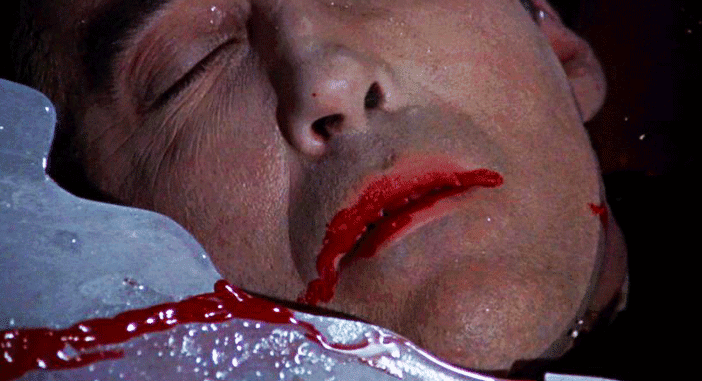
In the narrative’s present day, one year later, the same priest says mass before his altar boy in an otherwise empty church, then quickly adjourns to the nearest inn to start drinking. The behavior of the landlord and villagers in the room indicate the priest’s morning visit and the early start to his imbibing are by no means unusual. Times are hard for the local parish. The events last year left their place of worship desecrated and the villagers are reluctant to enter. The deserted church sits metaphorically and literally in the shadow of Dracula’s mountaintop castle and the evil it represents.

The solid and curly mutton-chopped actor Rupert Davies arrives. He plays a travelling monsignor, the priest’s denominational superior, who quickly assesses the situation and chastises the man for his inaction. Now that Dracula is vanquished, why hasn’t the priest exorcised and spiritually cleansed both the church and the castle? The answer, we can plainly see, is that the man is paralyzed with terror of the supernatural evil. He is quaking in his cassock, shaking in his vestments. His frailty and fragility are character flaws which becomes integral as the tale unfolds.
“There is no evil in the house of God!” The monsignor insists sternly, before taking his cleric aside.
“You can’t imagine what it’s like,” the priest insists, pleading with his eyes.
Clearly there are different gradations of belief operational here. The older man’s clarity, moral strength and the forceful impregnability of his faith far outstrip the poor priest’s.
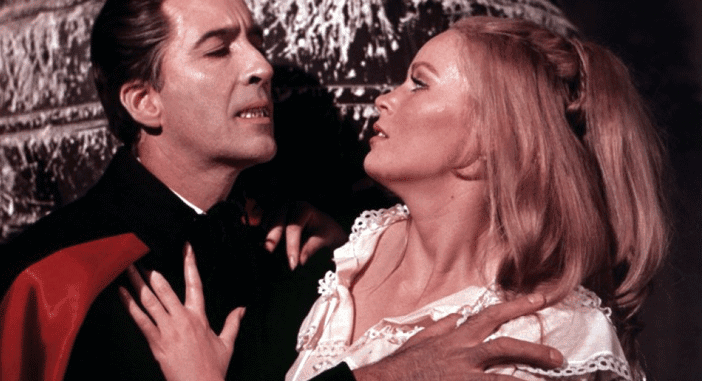
The monsignor orders his subordinate to meet him the next morning a half hour before dawn to begin what will be a daylong trek to the castle. Although it’s near enough to cast a shadow—and even though it’s accessible by horse and cart both in previous films and at the end of this movie—they must inexplicably journey all day through the fog-shrouded forest and climb the rocky mountain on foot to reach it. This is as much a symbolic journey as a physical one. The pilgrims must progress. The monsignor carries the church’s huge golden Gothic cross strapped to his back like a knapsack. The priest, out of shape from his year of depressed inactivity and drunkenness, can’t keep up with his superior even though the man appears 30 years older and as many pounds heavier. As sunset nears the cleric cannot go on. The monsignor takes pity on his weakness and continues up to the castle without him. As soon as he is out of sight, the priest pulls out a bottle and resumes his drinking.
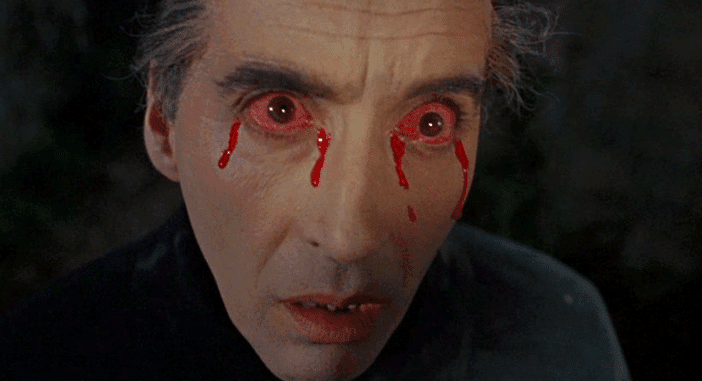
Good use is made of echo as the monsignor stands at the castle door and begins chanting his Latin exorcism. Dark clouds roll in and lightning fills the sky. The priest, somewhere down the side of the precipice, is scared by the cosmic forces at work and starts to flee. He trips and tumbles down the mountainside, knocking himself out and cutting open his forehead. He lands atop an ice-covered stream, his impact cracking the surface and exposing the body of Christopher Lee’s Count Dracula. As the winds pick up and the monsignor attaches the giant golden crucifix to the castle door, far below the blood trickles from the priest’s forehead directly into the mouth of the hibernating vampire. Its lips start to move as it swallows.
Exorcism over, the monsignor descends and returns to the village. The count, meanwhile, has woken up and towers behind the priest as he regains consciousness. Oddly, the cleric first glimpses the vampire standing behind him by seeing its reflection in the water. This is an odd gaffe, since the undead cannot traditionally be seen in reflections.
Dracula discovers his castle has now been reverse-desecrated with a huge gleaming cross attached to the front door. He demands the priest, whose weak will he easily enslaves, tell him who perpetrated this atrocity. The vampire learns it was the monsignor and vows revenge.
All of this, which transpires during the first 22 minutes of the film, is merely the setup. When the monsignor returns home to the township of Kleinenberg, the other main characters are introduced. His household consists of his dead brother’s wife Anna and his niece Maria (Veronica Carlson), a twentyish blonde with obvious endowments whose appearance virtually screams “Hammer Film vixen” from the moment we see her. It is through seeking to destroy her purity that the vampire will pursue his revenge on the monsignor.
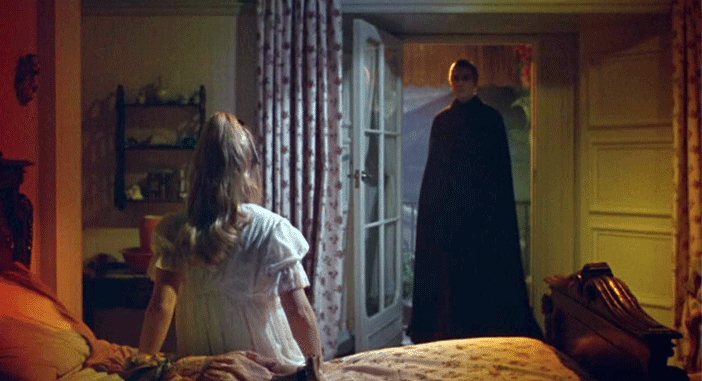
Maria is in love with Paul, a young scholar played by Barry Andrews, who resembles The Who’s Roger Daltrey enough to make viewers uncomfortable. When we first see him he is dressed in his finest suit to have dinner at Maria’s and meet her mother for the first time (he doesn’t know that her uncle the monsignor has arrived back home yet). He foolishly allows himself be talked into playing a college boys’ bar game, where a tall glass of frothy ale is balanced on the handle of a broomstick so that the top of the glass touches the cafe’s dirty ceiling beam—because beer presumably tastes better with wood splinters and dust. The person clutching the handle must turn in circles and drink their own ale at the same time. The inevitable happens and Paul spills the fragrant brew all over his suit. He has no time to change, so he ends up going to Maria’s birthday dinner this way.
Both this slapstick and the comic interactions with his irascible but paternal boss Max fall flat, but the beer dousing and resultant aroma do contribute to the young man’s uneasiness as he unexpectedly meets Maria’s prim and proper uncle for the first time and their worldviews collide. Paul is a second class pastry cook but a pragmatic scholar, and while the year the film takes place is never specified (although the date on the coffin Dracula steals is 1905), in the real world it is 1968—two years after Time magazine’s cover notoriously asked if God was dead. The youth is a fervent atheist, and Monsignor Ernst by nature and profession most assuredly is not. Paul is, however, a young man of noble and admirable character. We know this because in John Elder’s script he helpfully describes himself as “young, hard-working, good-looking (and) abstemious” in a conversation with his boss.
“What I don’t understand is what you hope to get out of those books of yours,” Max grouches amiably.
“What life’s about, something of The Truth,” Paul replies. He may not be on a magic bus, but we can call this Daltrey lookalike The Seeker.
The dinner party with the monsignor starts off pleasantly enough. The young man’s earnest manner impresses Ernst, who proclaims “Not enough people say what they really mean these days. Many people speak only to impress, not stopping to think if what they say is really true.”
When he is queried as to which church he goes to, Maria quickly tries to make excuses. She says he is very busy with his baking and studying. Paul, not carrying if people will try to put him d-d-down, will have none of it. He is forthright. The truth will set him free. “I don’t go to church, sir.”
He’s not trying to cause a b-b-big s-s-sensation, but Ernst reacts with horror. “You’re not a Protestant, are you?”
No such luck. “I’m an atheist, sir,” says Paul.
“You mean you deny the existence of God?” The Monsignor is stunned.
“I don’t deny it. I just don’t believe it. It’s my own opinion, sir.” Paul replies, revealing both his heartfelt conviction and that he may not have taken a class in Logic just yet.
He offers to leave and the mother, Anna, understandably says that might be best. She doesn’t mention it, but we know this is Ernst’s first night back after a long trip hiking up and down mountains, exorcising the home of a vampire, etc. Putting a stake through an atheist may be his next instinctual act. Better he gets more rest and settles down.
Paul lives upstairs in Max’s cafe, where he also does his baking and beer balancing. He goes home from Maria’s and gets drunk. He’s completely frustrated, having simply spoken with honesty and still coming into conflict with not only the monsignor’s beliefs, but his very profession. Using the interconnected rooftops of Kleinenberg as a private highway, Maria visits him to make amends for her uncle’s reaction and see that he’s okay. Supposed hilarity ensues as she and the barmaid with a heart of gold (talk about archetypes!) help him into bed. “What have you done with my legs?” Wah wah.
The rooftops see a lot of traffic. Not only do characters use them to commute back and forth, but there is also a memorable chase and confrontation a reel or two later as the monsignor interrupts an attack by Dracula and pursues him. This is a very symbolic film, and the action operates on several planes, both physical and spiritual. All through the story the local residents of Kleinenberg have no idea anything supernatural is going on. The only people Dracula’s presence affects are those who work at the inn and those living at the monsignor’s house. As far as the rest of town is concerned, nothing out of the ordinary takes place. The great spiritual and demonic contest takes place beyond their awareness, at a different level. It might just as well be a normal Tuesday.
In brisk succession, Dracula and his corrupted priest arrive in town, the vampire bites and enslaves the kindly barmaid, and through her influence the priest rents a room at the inn and stashes the master’s coffin/bunk deep in the basement in a huge unused larder. Director Freddie Francis keeps things moving along at a rapid pace, and the action never slows down during the 92 minute film.

Although the barmaid is vampified and destroyed, Maria is only bitten once, in her own bed. The director manages a nice touch as she grabs the arm of her doll during the bite, but shoves it away a moment later before it ends—effectively pushing away her innocence. The monsignor later examines her neck and immediately realizes what is happening. He delves into his books to find out what must be done to thwart his undead foe. After interrupting the creature’s second attack he chases him across the rooftops and is waylaid by the priest. “You!” he exclaims, as the man strikes him down with a heavy object.
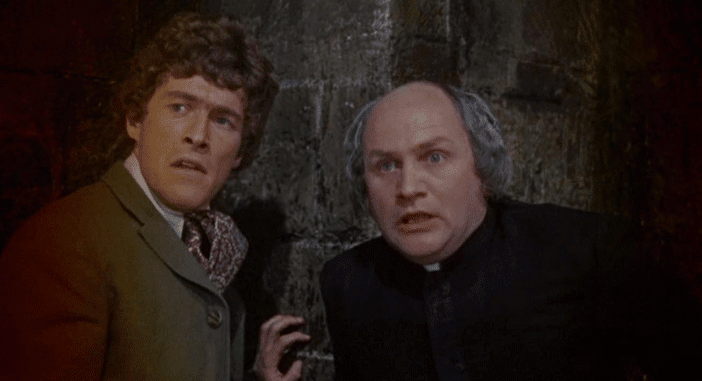
After crawling along the gables and awnings to get home, the monsignor has no strength left. Maria’s mother Anna helps him over the railing and back into the house, but it is clear he is dying. He entreats Anna to fetch Paul. She is amazed. Paul? The atheist? Yes, Paul. He obviously cares for Maria and may be her one best hope for protection.
Paul comes round at once. Unexpectedly and impulsively, he brings along the inn’s lodger—the enslaved priest who happens to be the enemy’s manservant. Monsignor Ernst tells Paul that Maria is being stalked by a vampire. Paul accepts this truth with a perfectly straight face. These books of the monsignor’s will tell him what to do, but he should swear in the name of the Lord that he will protect her. Paul cannot do this. His atheism again gets in the way. Instead, he says he will give his word. Ernst realizes that will have to be enough. Regardless of the disparity in their worldviews, the men are united in their love for Maria. The old man looks up, catches sight of the priest who attacked him standing in the room, and dies before he can utter a recrimination or warning.
Drafting the priest to help him by translating the Latin books aloud, Paul spreads garlic around doorframes and does the traditional things to ward off vampiric attack. It is not clear why the priest goes along with this at first, since he’s still under the power of Dracula. Surely he would not willingly aid in putting these talismans in place to ward him off. It is the first sign that the priest may be experiencing his own spiritual struggle. He knows helping perpetuate the evil is wrong, yet his will is so weak he cannot resist for long. This becomes apparent when he slugs Paul from behind and tries to remove the protective cross from Maria’s chest.
Only stunned, Paul wakes in time to stop him. He realizes the priest has been dancing with the devil in the pale moonlight, to employ a Jokerism. “What are you trying to do?...You, a priest!” He forces the weak willed man to take him to Dracula’s lair. Paul successfully plunges a large stake into the sleeping vampire’s chest, but it doesn’t kill him. “Pray! You must pray!” the priest exclaims. Belief, more than in any other film, is here essential to kill the monster. Paul still cannot do this. All he has effectively done is awoken his enemy. Dracula pulls out the stake and flees, dodging a shovelful of flaming coals from the bakery oven.
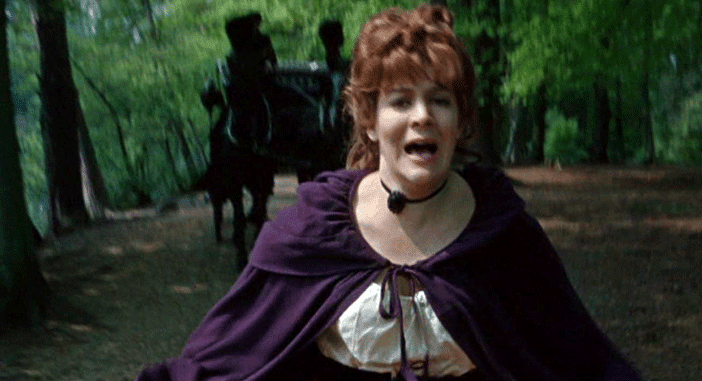
A nightgowned Maria seeks out Dracula on the rooftop. The priest takes her and the sleeping vampire by cart to his homeland. While the priest drives, the entranced Maria is in back literally fondling the coffin—another unusual but effective choice by the director. These touches combine to depict the moral corruption the creature’s power has. After it awakes they have to walk some distance through the woods and hills, and Maria’s bare feet are clearly cut up by the terrain, but they obviously ascend to the castle in considerably less time than it took the monsignor and the priest earlier in the film. The hours of night are shorter and no representational purpose will be achieved by drawing out the journey this time.
The vampire has Maria remove the giant golden crucifix from the castle door and hurl it over the stone railing. It lands upright far below between the rocks. Now its revenge is absolutely complete. Not only is the monsignor dead, but his beautiful niece is completely under its power and has restored its ability to enter the property. Dracula — and by extension evil — has triumphed.
Yet Paul is a man of his word. He vowed to protect Maria and has followed them from Kleinenberg. He shields Maria from the undead monster and Dracula grabs him. Together they tumble over the rampart, Paul grabbing a tree branch to save himself but his opponent falling squarely on the upper arm of the golden cross below. It pierces his back, protruding out of his chest. This may be the most memorable image of any Hammer Dracula film, as the impaled vampire struggles helplessly, blood dripping from his eyes.
The priest, in the same echo-enriched voice the monsignor used earlier to exorcise the castle, prays to the heavens in Latin and Dracula is destroyed. With yet another memorable visual flourish, director Francis shows us his cloak lying at the foot of the cross — a reverse evil image that might resonate with those who know what the centurions gambled over thousands of years ago. The cleric has found the strength to do what is right. Finally his faith has triumphed over his enslaved will. At last he has done what the monsignor asked him to do at the beginning of the film.
Paul witnesses all of this. Maria is free. As these two people bearing biblical names stand holding one another after evil has been vanquished, Paul can no longer doubt the spiritual reality of unseen powers. He now believes. This former atheist makes the sign of the cross and the film ends.
Peter Cushing, who often starred alongside Christopher Lee as Professor Van Helsing, found Hammer Films—for all their colorful gore and graphic evil—to be intensely moral. This resonated with his personal faith, and explained why he continued to make movies about monstrous events.
“It’s not His will that has caused disasters throughout the ages, but man’s disobedience and disregard. But he knows the human race will eventually learn what is right and what is wrong, suffering in the process,” Cushing said in the pages of Famous Monsters magazine. “Faith will sustain us during that journey...if we will let it.”
This is the key to his portrayal of Van Helsing, and indeed supplies the underlying message behind most Hammer horror tales. The filmmakers seem to suggest an ultimate good which shall emerge triumphant over evil — provided the protagonists display certitude and resolution.
The vampire is more dependent on, and vulnerable to, belief than any other cinematic monster. As this film tells us, and so memorably depicts, its evil can hardly be defeated without it.
Belief — and vigilance, lest evil return.
FRANK JAY GRUBER In addition to his freelance writing and editing gigs, Frank Jay Gruber teaches literature, composition and online course development at Bergen Community College in New Jersey. He sometimes covers New York and Philadelphia area events for TrekMovie.com, appears on convention panels and writes for genre websites like The Collinsport Historical Society. CNN interviewed him about Star Trek in his collectible-covered lair and consulted him about Dark Shadows after Jonathan Frid’s death in 2012. You can read his extremely infrequent musings at TheWearyProfessor.com and follow him on Twitter @FrankJayGruber.
